
Mangosteen, also known as the purple mangosteen, is a tropical evergreen tree with edible fruit tree native to Island Southeast Asia, from the Malay Peninsula to Borneo. It has been cultivated extensively in tropical Asia since ancient times. It is grown mainly in Southeast Asia, southwest India and other tropical areas such as Colombia, Puerto Rico and Florida, where the tree has been introduced. The tree grows from 6 to 25 m tall.

Garcinia is a genus of flowering plants in the family Clusiaceae native to Asia, America, Australia, tropical and southern Africa, and Polynesia. The number of species is disputed; Plants of the World Online (POWO) recognise up to 400. Commonly, the plants in this genus are called saptrees, mangosteens, or garcinias, and is one of several plants known as by the name "monkey fruit".
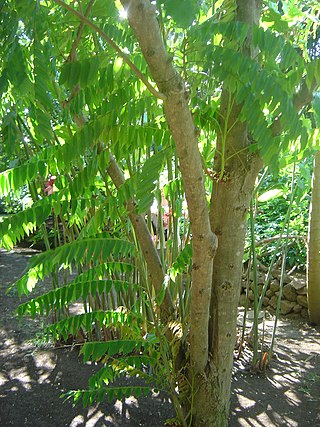
Averrhoa bilimbi is a fruit-bearing tree of the genus Averrhoa, family Oxalidaceae. It is believed to be originally native to the Maluku Islands of Indonesia but has naturalized and is common throughout Southeast Asia. It is cultivated in parts of tropical South Asia and the Americas. It bears edible extremely sour fruits. It is a close relative of the carambola tree.

Artocarpus odoratissimus is a species of flowering plant in the Moraceae family. It is a commonly called marang, madang, timadang, terap, tarap, kiran, green pedalai, or johey oak. It is native to Borneo, Palawan, and Mindanao Island, and is closely related to the jackfruit, cempedak, and breadfruit trees which all belong to the same genus, Artocarpus.

Spondias purpura is a species of flowering plant in the cashew family, Anacardiaceae, that is native to tropical regions of the Americas, from Mexico to northern Colombia and the southwest Caribbean Islands. It has also been introduced to and naturalized to other parts of the American tropics, Southeast Asia, and West Africa. It is commonly known as jocote, which derives from the Nahuatl word xocotl, meaning any kind of sour or acidic fruit. Other common names include red mombin, Spanish plum, purple mombin, Jamaica plum, and hog plum.

Garcinia prainiana, known as the button mangosteen or cherapu is a species of Garcinia. It has a flavor similar to, but distinct from, its cousin, the purple mangosteen, with an interesting taste some have compared to a tangerine, but unlike its cousin it has a tissue-thin skin rather than a hard rind, making it much easier to eat out-of-hand. Also unlike the purple mangosteen, it can be grown in a container. The fruit is cultivated in Southeast Asia, by a few backyard growers in South Florida, and at the Whitman Tropical Fruit Pavilion at Florida's Fairchild Tropical Botanic Garden.

Mangostin is a natural xanthonoid, a type of organic compound isolated from various parts of the mangosteen tree. It is a yellow crystalline solid with a xanthone core structure. Mangostin and a variety of other xanthonoids from mangosteen have been investigated for biological properties including antioxidant, anti-bacterial, anti-inflammatory, and anticancer activities.

Garcinia intermedia is a species of tropical American tree which produces tasty fruit. In English it is known as the lemon drop mangosteen or sometimes monkey fruit. In Spanish it is called mameyito, though it is known as jorco in Costa Rica. In the Philippines, it is known as berba. In Portuguese it is called achachairu. The name achachairu is also applied to Garcinia humilis, another species native to Bolivia with larger, round or egg-shaped fruit. G. humilis has been commercialized in Australia under the name Achacha.
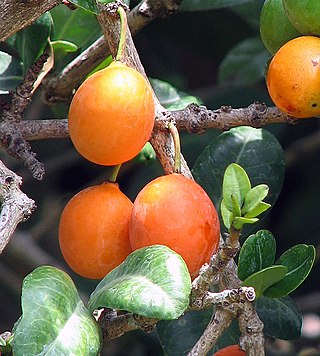
Garcinia livingstonei is a species of Garcinia, native to a broad area of tropical Africa, from Côte d'Ivoire east to Somalia, and south to South Africa.

Garcinia kola is a species of flowering plant belonging to the Mangosteen genus Garcinia of the family Clusiaceae. It is found in Benin, Cameroon, The Gambia, Democratic Republic of the Congo, Ivory Coast, Guinea, Mali, Gabon, Ghana, Liberia, Nigeria, Senegal and Sierra Leone. Its natural habitat is subtropical or tropical moist lowland forests.

Uvaria is a genus of flowering plants in the family Annonaceae. The generic name uvaria is derived from the Latin uva meaning grape, likely because the edible fruit of some species in the genus resemble grapes.

Garcinia morella is a species of tree in the family Clusiaceae found in India, and Sri Lanka.
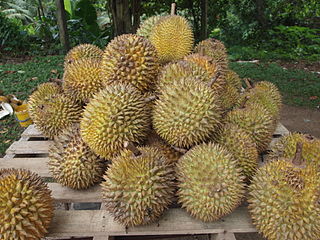
The durian is the edible fruit of several tree species belonging to the genus Durio. There are 30 recognized Durio species, at least nine of which produce edible fruit. Durio zibethinus, native to Borneo and Sumatra, is the only species available on the international market. It has over 300 named varieties in Thailand and 100 in Malaysia as of 1987. Other species are sold in their local regions.

Garcinia atroviridis, known as asam gelugur, asam gelugo, or asam keping is a large rainforest tree native to Peninsular Malaysia and Sumatra. This species grows wild throughout Peninsular Malaysia but is also widely cultivated, especially in the northern states, owing to its economic and medicinal value. Garcinia atroviridis is a large perennial plant commonly found in evergreen forests in the southern region of Thailand and Malaysia.
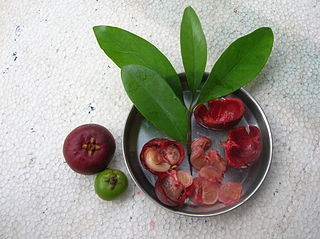
Garcinia indica, a plant in the mangosteen family (Clusiaceae), commonly known as kokum, is a fruit-bearing tree that has culinary, pharmaceutical, and industrial uses. It grows primarily in India's Western Ghats: in the states of Maharashtra, Goa, Karnataka and Kerala.
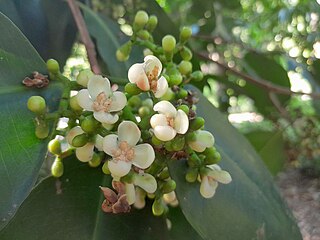
Garcinia warrenii, a is a fruit-bearing tree, up to 15 metres in height, of the mangosteen family (Clusiaceae), commonly known as native mangosteen or Warren's mangosteen. It is found in the tropical rainforests of northern and north-eastern Australia and New Guinea. The genus Garcinia, belonging to the family Clusiaceae, includes about 200 species found in the Old World tropics, mostly in Asia and Africa. Garcinia warrenii is indigenous to New Guinea, the Torres Strait Islands, northeastern Queensland from Cape York Peninsula south to Babinda, and a small, isolated population on Melville Island in the Northern Territory, Australia.
Garcinia parvifolia, the Kundong, Brunei cherry or Asam aur aur, is a tropical evergreen tree native to Borneo, Peninsular Malaysia, Sulawesi and Sumatra. The tree is found at elevations of 600–800 metres (2,000–2,600 ft) in humid environments, and grows to a height of 33 metres (108 ft). The bark, wood, leaves, and fruit of the kundong tree are used by humans.
Garcinia binucao is a species of flowering plant in the Clusiaceae family. It is commonly known as binukaw or batuan, is a species of Garcinia endemic to the Philippines. It is not cultivated, though its edible fruits are harvested from the wild for use as a souring agent in some Filipino dishes.

Garcinia subelliptica, commonly known as the happiness or Fukugi tree, is an evergreen tree found in coastal forests of East and Southeast Asia, specifically the Ryukyu Islands of Japan, Taiwan, Philippines, Indonesia, Sri Lanka, and India.

Garcinia cowa, commonly known as cowa fruit or cowa mangosteen is an evergreen plant with edible fruit native to Asia, India, Bangladesh, Myanmar, Malaysia, Vietnam, Laos, Cambodia, and southwest China. The tree is harvested from the wild for its edible fruits and leaves, which are used locally. Flowers are yellow, male & female flowers are separated.



















